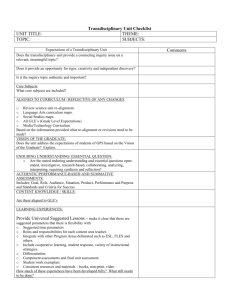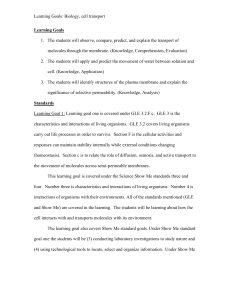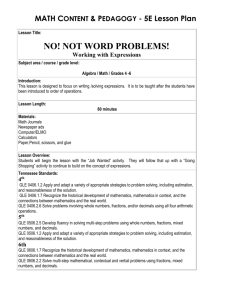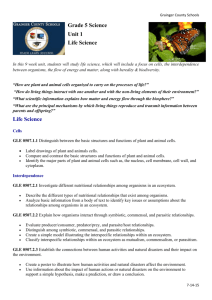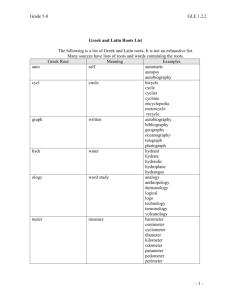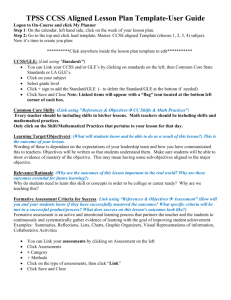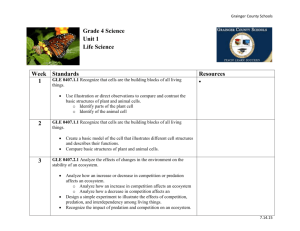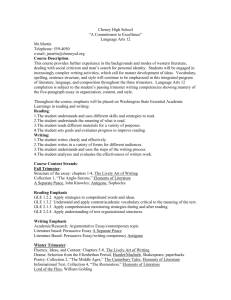iLEAP Science, Grade 7
advertisement
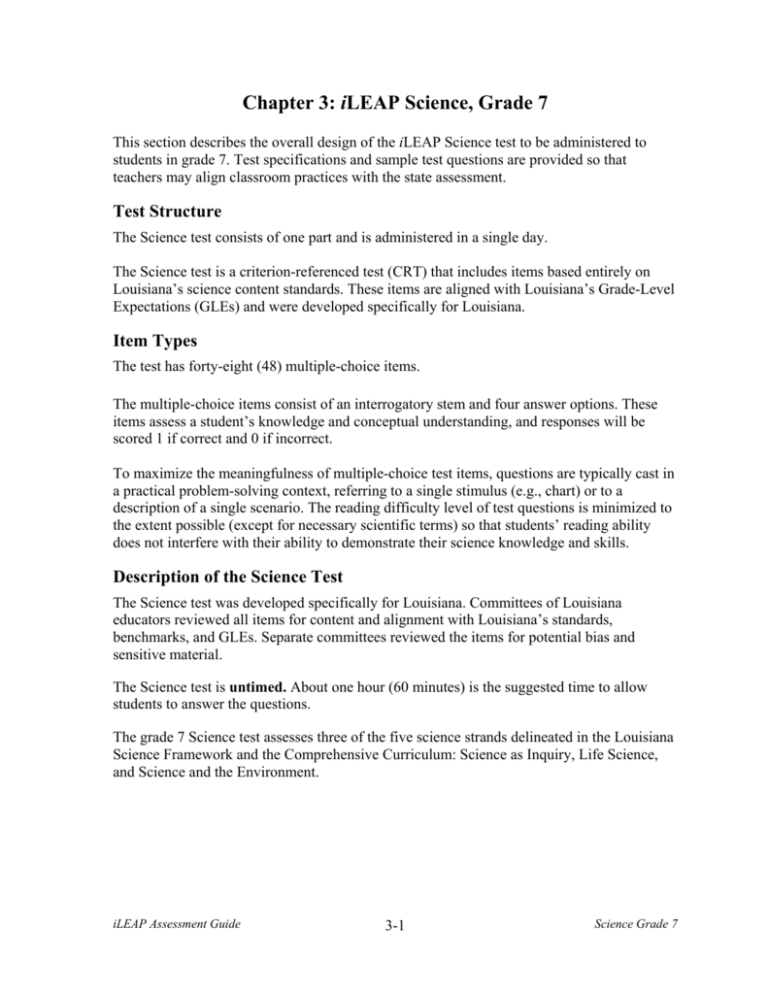
Chapter 3: iLEAP Science, Grade 7 This section describes the overall design of the iLEAP Science test to be administered to students in grade 7. Test specifications and sample test questions are provided so that teachers may align classroom practices with the state assessment. Test Structure The Science test consists of one part and is administered in a single day. The Science test is a criterion-referenced test (CRT) that includes items based entirely on Louisiana’s science content standards. These items are aligned with Louisiana’s Grade-Level Expectations (GLEs) and were developed specifically for Louisiana. Item Types The test has forty-eight (48) multiple-choice items. The multiple-choice items consist of an interrogatory stem and four answer options. These items assess a student’s knowledge and conceptual understanding, and responses will be scored 1 if correct and 0 if incorrect. To maximize the meaningfulness of multiple-choice test items, questions are typically cast in a practical problem-solving context, referring to a single stimulus (e.g., chart) or to a description of a single scenario. The reading difficulty level of test questions is minimized to the extent possible (except for necessary scientific terms) so that students’ reading ability does not interfere with their ability to demonstrate their science knowledge and skills. Description of the Science Test The Science test was developed specifically for Louisiana. Committees of Louisiana educators reviewed all items for content and alignment with Louisiana’s standards, benchmarks, and GLEs. Separate committees reviewed the items for potential bias and sensitive material. The Science test is untimed. About one hour (60 minutes) is the suggested time to allow students to answer the questions. The grade 7 Science test assesses three of the five science strands delineated in the Louisiana Science Framework and the Comprehensive Curriculum: Science as Inquiry, Life Science, and Science and the Environment. iLEAP Assessment Guide 3-1 Science Grade 7 Description of Stimulus Material The stimulus material may include: • Data tables or graphs presenting data to be read or interpreted; • Charts, illustrations, or graphic organizers; • Descriptions and details of science investigations; and • Maps showing geographical features. Scoring Information The iLEAP Science test contains multiple-choice items only. These items have four response options (A, B, C, D) and are scored right or wrong. Correct answers receive a score of 1; incorrect answers receive a score of 0. Science Test Specifications Table 12 provides the test specifications for the grade 7 iLEAP Science assessment. The values in the table are approximations due to slight variations in the content across test forms. Table 12: Grade 7 Science Test Specifications Strand/Category % of Total Points Science as Inquiry A. The Abilities Necessary to Do Scientific Inquiry 42 B. Understanding Scientific Inquiry Life Science A. Structure and Function in Living Things 42 B. Reproduction and Heredity C. Populations and Ecosystems D. Adaptations of Organisms 16 Science and the Environment Total 100 Strands, Benchmarks, and GLEs Assessed Louisiana’s Science Framework encompasses five strands: Science as Inquiry, Physical Science, Life Science, Earth and Space Science, and Science and the Environment. At grade 7, three strands are addressed: Science as Inquiry, Life Science, and Science and the Environment. The Louisiana science strands are each associated with a single standard, which present broad goals for what all students in Louisiana should know and be able to do in science: iLEAP Assessment Guide 3-2 Science Grade 7 Science as Inquiry (SI) Strand Standard: The students will do science by engaging in partial and full inquiries that are within their developmental capabilities. Life Science (LS) Strand Standard: The students will become aware of the characteristics and life cycles of organisms and understand their relationships to each other and to their environment. Science and the Environment (SE) Strand Standard: In learning environmental science, students will develop an appreciation of the natural environment, learn the importance of environmental quality, and acquire a sense of stewardship. As consumers and citizens, they will be able to recognize how our personal, professional, and political actions affect the natural world. The focus for grade 7 Louisiana students is life science concepts. The content explored at this grade level includes the chemistry of life, plant and animal cells, living organisms, ecology, balance within ecosystems, reproduction, heredity, health and diseases, and food webs and cycles. For this reason, the grade 7 iLEAP Science test assesses the following stands: Science as Inquiry, Life Science, and Science and the Environment. Science as Inquiry is a process strand; the others are content strands. The organization into strands does not imply that science should be taught in isolated units. In fact, teachers are encouraged to integrate study units. Inquiry should be integrated across all the science content strands. The GLEs specify the knowledge and skills students are expected to master by the end of each grade or high school course. The GLEs for each grade are developmentally appropriate and increase in complexity to build the knowledge and skills students need. Most of the grade 7 GLEs are eligible for assessment on the grade 7 iLEAP. Some, however, do not lend themselves to testing on a statewide assessment in multiple-choice format. For example, some GLEs require students to use a particular technology, construct models, write the steps in an investigation, draw a diagram or construct or draw food webs. Other GLEs, in accordance with the Comprehensive Curriculum, may not be taught prior to the spring test administration and therefore will not be assessed. Science as Inquiry GLEs 7, 8, 9, 14, 15, 19, 20, 24, and 37 are not assessed. Physical Science GLE 1 is not assessed. Life Science GLEs 21 and 40 are not assessed. It is important, however, that the skills represented by these GLEs are taught at this grade level to prepare students for classroom assessment as well as the grade 8 LEAP test. iLEAP Assessment Guide 3-3 Science Grade 7 Explanation of Codes GLEs are numbered consecutively in each grade level and grouped by strand and thematic category. For example: Strand: Categories: Life Science A. Structure and Function in Living Systems B. Reproduction and Heredity C. Populations and Ecosystems D. Adaptations of Organisms Benchmarks are coded by strand, grade cluster (E, M, H), and benchmark number. The first term in the code refers to the strand. The second term refers to the grade cluster, and the third term refers to the category and benchmark number. Categories are indicated by letters. Table 13 provides three examples of benchmark codes. Table 13: Examples of Science Codes Code Translation SI-E-A5 SI strand, Elementary level, category A, benchmark 5 LS-M-B3 LS strand, Middle School level, category B, benchmark 3 SE-H-A6 SE strand, High School level, category A, benchmark 6 For most grade clusters, strands are divided into categories, or major topical areas. However, the SE strand has no substrands for prekindergarten through 4 and 5 through 8. Science GLEs are numbered consecutively in Science as Inquiry and consecutively within the content strands. Science As Inquiry— GLEs 1– 40 Physical Science —GLE 1 Life Science— GLEs 2–34 Science and the Environment— G LEs 35– 43 Key Concepts for the Grade 7 Assessment Key concepts are provided to guide teachers in their classroom instruction as it relates to the assessment. These concepts describe important content emphasis regarding the knowledge and skills eligible for assessment of each strand. iLEAP Assessment Guide 3-4 Science Grade 7 Science as Inquiry 1. Designing an Investigation • Identify testable questions, questions that guide investigations/experiments, and questions to consider during an investigation • Identify problems in an investigation • Identify the components of an investigation • Use multiple sources to answer questions • Select appropriate experimental design or setup • Predict outcomes of an investigation • Identify correct procedure in an investigation • Identify independent variable, dependent variable, and variables that should be controlled/constant • Select appropriate tools, equipment, and technology to use in an investigation • Measure using appropriate or accurate units of the metric system • Identify appropriate safety tools and procedures • Identify correct setup between varying investigations • Identify ways to improve the investigation • Identify mistakes in procedures • Identify alternate methods for investigation using same tools 2. Communication • Understand and be able to identify the difference between a description and an explanation • Understand and be able to identify the difference between an observation and an inference • Use data tables, charts, circle graphs, line graphs, bar graphs, diagrams, scatter plots, and symbols to collect, record, and report data • Develop an explanation of experimental results • Identify patterns in data • Use models to explain natural phenomena or conclusions from investigations • Predict trends supported by data • Recognize that there are multiple ways to interpret data that may result in alternate explanations • Identify statements not supported by data/faulty reasoning • Communicate results of investigations • Identify statements that explain data 3. Technology and the work of the scientists • Recognize that scientists use logical processes to solve problems • Review other scientists’ work before beginning an investigation • Recognize that technology expands the human senses • Recognize that present technology limits answering all questions • Recognize that there is an acceptable range of variation in collected data • Identify mean, median, mode, and range from a given set of data iLEAP Assessment Guide 3-5 Science Grade 7 • • • • • • • Identify problems in models, experimental design Understand how scientists communicate about investigations in progress and findings Describe how/why scientific theories change Verify experiments through multiple investigation/trials Solve problems and form new ideas as a result of scientific investigations Identify ways technology has changed human life Evaluate the impact of research on scientific thought, society, and the environment Life Science 1. Plant and Animal Cells • Identify and compare cell structures and functions • Describe osmosis and diffusion • Compare plant and animal cell structures • Explain the processes of photosynthesis and respiration using a word equation • Differentiate between aerobic and anaerobic respiration in cells 2. Human Development • Describe the function of organs within major systems (digestive, respiratory, nervous, circulatory) • Describe how one or more major organ systems interact to sustain human life (endocrine, reproductive, nervous, respiratory, skeletal, muscular, circulatory, digestive) • Describe human development from infancy to old age • Describe how external factors and genetics influence quality and length of human life • Explain how communicable and noncommunicable diseases are transmitted, treated, and prevented 3. Genetics and Reproduction • Identify statements that describe sexual and asexual reproduction • Compare mitosis and meiosis and differentiate between the cell divisions in each process • Explain why chromosomes in body cells exist in pairs • Explain the relationship of genes to chromosomes • Explain the relationship of genotypes to phenotypes • Recognize genetic errors caused by changes in chromosomes • Use a Punnett square to determine offspring in simple monohybrid crosses • Identify dominant, recessive, and incomplete dominant traits from a given scenario • Identify examples of selective breeding 5. Organisms and Ecosystems • Use a dichotomous key to classify organisms • Identify organisms with complete and incomplete metamorphosis • Compare life cycles of plants and animals • Determine energy transfer among organisms by analyzing food webs iLEAP Assessment Guide 3-6 Science Grade 7 • • • • • • • • • • Describe the major biomes of the world and identify organisms Identify the levels of organization of living things within an ecosystem o producers, primary consumers, secondary consumers, decomposers o individual, population, community Identify mutualistic, parasitic, and producer/consumer relationships among plants and animals Differentiate between habitat and niche Predict the changes that a species population has on an ecosystem using a given scenario Differentiate between behavioral and structural adaptations Determine the impact of introducing nonnative species into an ecosystem Determine an organism’s ability to survive during changes that occur in various ecosystems Identify that variations in individual organisms within a population determine the success of the population Identify environmental factors that impact the survival of a population Science and the Environment • • • • • • • • Identify resources that humans derive from ecosystems (wetlands, tropical rainforests, tundra) Identify the roles of biotic and abiotic components in various ecosystems Describe the effects of limiting factors on a given population Determine the carrying capacity of an ecosystem using a given scenario Identify the consequences of human actions on ecosystems Explain why the nitrogen cycle is important to the survival of organisms Relate photosynthesis and respiration to the carbon cycle Identify positive and negative effects that human use of technology has on the environment iLEAP Assessment Guide 3-7 Science Grade 7 Grade 7 Science Standards, Benchmarks, and GLEs The following chart presents all grade 7 science strands and standards, benchmarks, and GLEs. GRADE 7 SCIENCE STANDARDS, BENCHMARKS, AND GLES Science as Inquiry: The students will do science by engaging in partial and full inquiries that are within their developmental capabilities. A. The Abilities Necessary to Do Scientific Inquiry Benchmarks Grade-Level Expectations SI-M-A1: identifying questions that can be used to design a scientific investigation 1. Generate testable questions about objects, organisms, and events that can be answered through scientific investigation (SI-M-A1) 2. Identify problems, factors, and questions that must be considered in a scientific investigation (SI-M-A1) 3. Use a variety of sources to answer questions (SI-M-A1) SI-M-A2: designing and conducting a scientific investigation 4. Design, predict outcomes, and conduct experiments to answer guiding questions (SI-M-A2) 5. Identify independent variables, dependent variables, and variables that should be controlled in designing an experiment (SI-M-A2) SI-M-A3: using mathematics and appropriate tools and techniques to gather, analyze, and interpret data 6. Select and use appropriate equipment, technology, tools, and metric system units of measurement to make observations (SI-M-A3) 7. Record observations using methods that complement investigations (e.g., journals, tables, charts) (SI-M-A3) 8. Use consistency and precision in data collection, analysis, and reporting (SI-M-A3) 9. Use computers and/or calculators to analyze and interpret quantitative data (SI-M-A3) iLEAP Assessment Guide 3-8 Science Grade 7 SI-M-A4: developing descriptions, explanations, and graphs using data 10. Identify the difference between description and explanation (SI-M-A4) 11. Construct, use, and interpret appropriate graphical representations to collect, record, and report data (e.g., tables, charts, circle graphs, bar and line graphs, diagrams, scatter plots, symbols) (SI-M-A4) 12. Use data and information gathered to develop an explanation of experimental results (SI-M-A4) 13. Identify patterns in data to explain natural events (SI-M-A4) SI-M-A5: developing models and predictions using the relationships between data and explanations 14. Develop models to illustrate or explain conclusions reached through investigation (SI-M-A5) 15. Identify and explain the limitations of models used to represent the natural world (SI-M-A5) 16. Use evidence to make inferences and predict trends (SI-M-A5) SI-M-A6: comparing alternative explanations and predictions 17. Recognize that there may be more than one way to interpret a given set of data, which can result in alternative scientific explanations and predictions (SI-M-A6) 18. Identify faulty reasoning and statements that misinterpret or are not supported by the evidence (SI-M-A6) SI-M-A7: communicating scientific procedures, information, and explanations 19. Communicate ideas in a variety of ways (e.g., symbols, illustrations, graphs, charts, spreadsheets, concept maps, oral and written reports, equations) (SI-M-A7) 20. Write clear, step-by-step instructions that others can follow to carry out procedures or conduct investigations (SI-M-A7) 21. Distinguish between observations and inferences (SI-M-A7) 22. Use evidence and observations to explain and communicate the results of investigations (SI-M-A7) SI-M-A8: utilizing safety procedures during scientific investigations 23. Use relevant safety procedures and equipment to conduct scientific investigations (SI-M-A8) 24. Provide appropriate care and utilize safe practices and ethical treatment when animals are involved in scientific field and laboratory research (SI-M-A8) iLEAP Assessment Guide 3-9 Science Grade 7 B. Understanding Scientific Inquiry SI-M-B1: recognizing that different kinds of questions guide different kinds of scientific investigations 25. Compare and critique scientific investigations (SI-M-B1) 26. Use and describe alternate methods for investigating different types of testable questions (SI-M-B1) 27. Recognize that science uses processes that involve a logical and empirical, but flexible, approach to problem solving (SI-M-B1) SI-M-B2: communicating that current scientific knowledge guides scientific investigations 28. Recognize that investigations generally begin with a review of the work of others (SI-M-B2) SI-M-B3: understanding that mathematics, technology, and scientific techniques used in an experiment can limit or enhance the accuracy of scientific knowledge 29. Explain how technology can expand the senses and contribute to the increase and/or modification of scientific knowledge (SI-M-B3) 30. Describe why all questions cannot be answered with present technologies (SI-M-B3) 31. Recognize that there is an acceptable range of variation in collected data (SI-M-B3) 32. Explain the use of statistical methods to confirm the significance of data (e.g., mean, median, mode, range) (SI-M-B3) SI-M-B4: using data and logical arguments to propose, modify, or elaborate on principles and models 33. Evaluate models, identify problems in design, and make recommendations for improvement (SI-M-B4) SI-M-B5: understanding that scientific knowledge is enhanced through peer review, alternative explanations, and constructive criticism 34. Recognize the importance of communication among scientists about investigations in progress and the work of others (SI-M-B5) 35. Explain how skepticism about accepted scientific explanations (i.e., hypotheses and theories) leads to new understanding (SI-M-B5) 36. Explain why an experiment must be verified through multiple investigations and yield consistent results before the findings are accepted (SI-M-B5) 37. Critique and analyze their own inquiries and the inquiries of others (SI-M-B5) SI-M-B6: communicating that scientific investigations can result in new ideas, new methods or procedures, and new technologies 38. Explain that, through the use of scientific processes and knowledge, people can solve problems, make decisions, and form new ideas (SI-M-B6) SI-M-B7: understanding that scientific development/technology is driven by societal needs and funding 39. Identify areas in which technology has changed human lives (e.g., transportation, communication, geographic information systems, DNA fingerprinting) (SI-M-B7) 40. Evaluate the impact of research on scientific thought, society, and the environment (SI-M-B7) iLEAP Assessment Guide 3-10 Science Grade 7 Physical Science: Students will develop an understanding of the characteristics and interrelationships of matter and energy in the physical world. A. Properties And Changes Of Properties In Matter Benchmarks Grade-Level Expectations PS-M-A1: investigating, measuring, and communicating the properties of different substances which are independent of the amount of the substance Not addressed at grade 7 PS-M-A2: understanding that all matter is made up of particles called atoms and that atoms of different elements are different PS-M-A3: grouping substances according to similar properties and/or behaviors PS-M-A4: understanding that atoms and molecules are perpetually in motion PS-M-A5: investigating the relationships among temperature, molecular motion, phase changes, and physical properties of matter PS-M-A6: investigating chemical reactions between different substances to discover that new substances formed may have new physical properties and do have new chemical properties PS-M-A7: understanding that during a chemical reaction in a closed system, the mass of the products is equal to that of the reactants PS-M-A8: discovering and recording how factors such as temperature influence chemical reactions PS-M-A9: identifying elements and compounds found in common foods, clothing, household materials, and automobiles 1. Identify the elements most often found in living organisms (e.g., C, N, H, O, P, S, Ca, Fe) (PS-M-A9) B. Motions and Forces There are no Grade-Level Expectations for benchmarks in grade 7 for this category. C. Transformations of Energy There are no Grade-Level Expectations for benchmarks in grade 7 for this category. iLEAP Assessment Guide 3-11 Science Grade 7 Life Science: The students will become aware of the characteristics and life cycles of organisms and understand their relationships to each other and to their environment. A. Structure and Function in Living Systems Benchmarks Grade-Level Expectations LS-M-A1: describing the observable components and functions of a cell, such as the cell membrane, nucleus, and movement of molecules into and out of cells 2. Compare the basic structures and functions of different types of cells (LS-M-A1) 3. Illustrate and demonstrate osmosis and diffusion in cells (LS-M-A1) LS-M-A2: comparing and contrasting the basic structures and functions of different plant and animal cells 4. Compare functions of plant and animal cell structures (i.e., organelles) (LS-M-A2) LS-M-A3: observing and analyzing the growth and development of selected organisms, including a seed plant, an insect with complete metamorphosis, and an amphibian 5. Compare complete and incomplete metamorphosis in insects (e.g., butterflies, mealworms, grasshoppers) (LS-M-A3) 6. Compare the life cycles of a variety of organisms, including nonflowering and flowering plants, reptiles, birds, amphibians, and mammals (LS-M-A3) LS-M-A4: describing the basic processes of photosynthesis and respiration and their importance to life 7. Construct a word equation that illustrates the processes of photosynthesis and respiration (LS-M-A4) 8. Distinguish between aerobic respiration and anaerobic respiration (LS-M-A4) LS-M-A5: investigating human body systems and their functions (including circulatory, digestive, skeletal, respiratory) 9. Relate structural features of organs to their functions in major systems (LS-M-A5) 10. Describe the way major organ systems in the human body interact to sustain life (LS-M-A5) LS-M-A6: describing how the human body changes with age and listing factors that affect the length and quality of life 11. Describe the growth and development of humans from infancy to old age (LS-M-A6) 12. Explain how external factors and genetics can influence the quality and length of human life (e.g., nutrition, smoking, drug use, exercise) (LS-M-A6) LS-M-A7: describing communicable and noncommunicable diseases 13. Identify and describe common communicable and noncommunicable diseases and the methods by which they are transmitted, treated, and prevented (LS-M-A7) B. Reproduction and Heredity LS-M-B1: describing the importance of body cell division (mitosis) and sex cell production (meiosis) iLEAP Assessment Guide 14. Differentiate between sexual and asexual reproduction (LS-M-B1) 15. Contrast the processes of mitosis and meiosis in relation to growth, repair, reproduction, and heredity (LS-M-B1) 3-12 Science Grade 7 LS-M-B2: describing the role of chromosomes and genes in heredity 16. Explain why chromosomes in body cells exist in pairs (LS-M-B2) 17. Explain the relationship of genes to chromosomes and genotypes to phenotypes (LS-M-B2) 18. Recognize genetic errors caused by changes in chromosomes (LS-M-B2) LS-M-B3: describing how heredity allows parents to pass certain traits to offspring 19. Apply the basic laws of Mendelian genetics to solve simple monohybrid crosses, using a Punnett square (LS-M-B3) 20. Explain the differences among the inheritance of dominant, recessive, and incomplete dominant traits (LS-M-B3) 21. Use a Punnett square to demonstrate how sexlinked traits are inherited (LS-M-B3) 22. Give examples of the importance of selective breeding (e.g., domestic animals, livestock, horticulture) (LS-M-B3) C. Populations and Ecosystems LS-M-C1: constructing and using classification systems based on the structure of organisms 23. Classify organisms based on structural characteristics, using a dichotomous key (LS-M-C1) LS-M-C2: modeling and interpreting food chains and food webs 24. Analyze food webs to determine energy transfer among organisms (LS-M-C2) LS-M-C3: investigating major ecosystems and recognizing physical properties and organisms within each 25. Locate and describe the major biomes of the world (LS-M-C3) 26. Describe and compare the levels of organization of living things within an ecosystem (LS-M-C3) LS-M-C4: explaining the interaction and interdependence of nonliving and living components within ecosystems 27. Identify the various relationships among plants and animals (e.g., mutualistic, parasitic, producer/consumer) (LS-M-C4) 28. Differentiate between ecosystem components of habitat and niche (LS-M-C4) 29. Predict the impact changes in a species’ population have on an ecosystem (LS-M-C4) D. Adaptations of Organisms LS-M-D1: describing the importance of plant and animal adaptation, including local examples 30. Differentiate between structural and behavioral adaptations in a variety of organisms (LS-M-D1) 31. Describe and evaluate the impact of introducing nonnative species into an ecosystem (LS-M-D1) LS-M-D2: explaining how some members of a species survive under changed environmental conditions 32. Describe changes that can occur in various ecosystems and relate the changes to the ability of an organism to survive (LS-M-D2) 33. Illustrate how variations in individual organisms within a population determine the success of the population (LS-M-D2) 34. Explain how environmental factors impact survival of a population (LS-M-D2) iLEAP Assessment Guide 3-13 Science Grade 7 Earth and Space Science: The students will develop an understanding of the properties of earth materials, the structure of the Earth system, the Earth’s history, and the Earth’s place in the universe. There are no Grade-Level Expectations for benchmarks in grade 7 for this strand. Science and the Environment: In learning environmental science, students will develop an appreciation of the natural environment, learn the importance of environmental quality, and acquire a sense of stewardship. As consumers and citizens, they will be able to recognize how our personal, professional, and political actions affect the natural world. Benchmarks Grade-Level Expectations SE-M-A1: demonstrating knowledge that an ecosystem includes living and nonliving factors and that humans are an integral part of ecosystems 35. Identify resources humans derive from ecosystems (SE-M-A1) 36. Distinguish the essential roles played by biotic and abiotic components in various ecosystems (SE-M-A1) SE-M-A2: demonstrating an understanding of how carrying capacity and limiting factors affect plant and animal populations 37. Identify and describe the effects of limiting factors on a given population (SE-M-A2) 38. Evaluate the carrying capacity of an ecosystem (SE-M-A2) SE-M-A3: defining the concept of pollutant and describing the effects of various pollutants on ecosystems Not addressed at grade 7 SE-M-A4: understanding that human actions can create risks and consequences in the environment 39. Analyze the consequences of human activities on ecosystems (SE-M-A4) SE-M-A5: tracing the flow of energy through an ecosystem and demonstrating a knowledge of the roles of producers, consumers, and decomposers in the ecosystem 40. Construct or draw food webs for various ecosystems (SE-M-A5) SE-E-A6: distinguishing between renewable and nonrenewable resources and understanding that nonrenewable natural resources are not replenished through the natural cycles and thus are strictly limited in quantity Not addressed at grade 7 SE-M-A7: demonstrating knowledge of the natural cycles, such as the carbon cycle, nitrogen cycle, water cycle, and oxygen cycle 41. Describe the nitrogen cycle and explain why it is important for the survival of organisms (SE-M-A7) 42. Describe how photosynthesis and respiration relate to the carbon cycle (SE-M-A7) SE-M-A8: investigating and analyzing how technology affects the physical, chemical, and biological factors in an ecosystem 43. Identify and analyze the environmental impact of humans’ use of technology (e.g., energy production, agriculture, transportation, human habitation) (SE-M-A8) SE-M-A9: demonstrating relationships of characteristics of soil types to agricultural practices and productivity Not addressed at grade 7 SE-M-A10: identifying types of soil erosion and preventive measures iLEAP Assessment Guide 3-14 Science Grade 7 Sample Test Items: Grade 7 Science Science as Inquiry The Abilities Necessary to Do Scientific Inquiry GLE 2— Identify problems, factors, and questions that must be considered in a scientific investigation (SI-M-A1) 1 A scientist studied a species of fish. She found that when a certain nutrient was added to the diet of the fish just after hatching, the fish gained an average of 3 kilograms in the first year. What additional information is needed to determine whether the nutrient is affecting the growth of the fish? A B C D how much adult fish gained on average when the same nutrient was added to their diet how much newly hatched fish in this species gain in the first year without the nutrient in their diet how much of the nutrient is available for the fish species in their natural surroundings how much other species of fish gain in the first year when the nutrient is added to their diet Correct Response: B Match to GLE: This item asks the student to identify a key question that affects the formulation of a scientific theory. Other grade 7 iLEAP items that measure this GLE may address other problems, factors, and questions that must be considered in scientific investigations. iLEAP Assessment Guide 3-15 Science Grade 7 Science as Inquiry The Abilities Necessary to Do Scientific Inquiry GLE 4—Design, predict outcomes, and conduct experiments to answer guiding questions (SI-M-A2) Use this data chart to answer question 2. Plant Experiment Plant Fertilizer (milliliters) Sunlight (hours/day) Water (milliliters per day) Height at beginning of experiment (cm) 1 50 8 100 22.5 2 50 10 100 21.7 3 50 12 100 21.5 4 50 14 100 22.0 2 Height at end of experiment (cm) Which question is the experiment most likely designed to answer? A B C D What are the effects of water on plant growth? What amount of fertilizer is best to use for plants? How does the height of a plant affect how much sunlight it needs? How does the amount of sunlight a plant receives affect its growth? Correct Response: D Match to GLE: This item relates to the design of an experiment. Other grade 7 iLEAP items that measure this GLE may ask students to predict outcomes of experiments. iLEAP Assessment Guide 3-16 Science Grade 7 Science as Inquiry The Abilities Necessary to Do Scientific Inquiry GLE 12—Use data and information gathered to develop an explanation of experimental results (SI-M-A4) Use the data table and picture to answer question 3. Breathing Experiment 3 Glass Time for candle to go out (seconds) 1 12 2 9 3 15 4 7 To model an animal breathing in an enclosed environment, Jackie lit a candle and placed a glass over the candle with the open end down. She measured how long it took for the candle flame to go out. She repeated her experiment with three other glasses, each time using the same candle. Jackie’s results are shown in the data table. Based on the data, which statement is most likely true? A B C D Glass 3 is the largest glass. Glass 4 is the hottest glass. Glass 1 is the coldest glass. Glass 2 is the smallest glass. Correct Response: A Match to GLE: This item asks the student to relate experimental data to an explanation of results. iLEAP Assessment Guide 3-17 Science Grade 7 Science as Inquiry The Abilities Necessary to Do Scientific Inquiry GLE 13—Identify patterns in data to explain natural events (SI-M-A4) Use this graph to answer question 4. Height of Flowers at Different Elevations Flower Height (centimeters) 40 30 20 10 0 0 1000 2000 3000 4000 5000 Elevation (meters) 4 A scientist studying a species of flower that grows on the side of a mountain measured the height of many of the flowers at different elevations. His results are shown in the graph. Which statement best describes the pattern of growth for the flowers during this experiment? A B C D The flowers’ heights are unaffected by elevation. The flowers cannot grow below elevations of 1,000 meters. The flowers grow best at elevations of around 3,000 meters. The flowers’ heights increase with higher elevation. Correct Response: C Match to GLE: This item asks the student to explain a natural event based on patterns in data. iLEAP Assessment Guide 3-18 Science Grade 7 Science as Inquiry The Abilities Necessary to Do Scientific Inquiry GLE 18—Identify faulty reasoning and statements that misinterpret or are not supported by the evidence (SI-M-A6) Use the data table below to answer question 5. Snail Coloring Sea Snail Species Red Foot Snail White Foot Snail 5 Shell Color Brown Brown Underside Color Red White Maximum Length 150 mm 180 mm A scientist studied two species of sea snail and recorded the physical characteristics in the data table. Which conclusion about the data is based on correct reasoning? A B C D If a snail she studied had a brown shell, then it was a red foot snail. If a snail she studied had a brown shell, then it had a white underside. If a snail she studied was 125 millimeters long, then it was red foot snail. If a snail she studied was 175 millimeters long, then it had a white underside. Correct Response: D Match to GLE: This item asks students to identify a statement that follows logically from data in a table. Other grade 7 iLEAP items that measure this GLE may relate to faulty reasoning and misinterpretation of data. iLEAP Assessment Guide 3-19 Science Grade 7 Science as Inquiry The Abilities Necessary to Do Scientific Inquiry GLE 22—Use evidence and observations to explain and communicate the results of investigations (SI-M-A7) 6 A scientist discovers that a certain substance will be useful in treating nerve damage. What is the best way she can communicate her results to the scientific community? A B C D She can call other scientists who also work in nerve research. She can write a letter to hospitals that treat patients with nerve damage. She can put her conclusions on a Web site that focuses on the nervous system. She can publish her results in a scientific journal that covers issues relating to nerves. Correct Response: D Match to GLE: This item relates to the communication of scientific results. Science as Inquiry Understanding Scientific Inquiry GLE 27—Recognize that science uses processes that involve a logical and empirical, but flexible, approach to problem solving (SI-M-B1) 7 Leslie’s science teacher told her she must take a flexible approach to solving problems. What did Leslie’s teacher most likely mean? A B C D Leslie should not follow the experimental instructions exactly. Leslie should only write down lab results that seem to be correct. Leslie should accept all scientific theories even if they have been proven wrong. Leslie should be willing to consider many possible causes for her observations. Correct Response: D Match to GLE: This item asks the student to identify what is meant by a flexible approach to science. Other grade 7 iLEAP items that measure this GLE may relate to other scientific attitudes that play a role in problem solving. iLEAP Assessment Guide 3-20 Science Grade 7 Science as Inquiry Understanding Scientific Inquiry GLE 28—Recognize that investigations generally begin with a review of the work of others (SI-M-B2) 8 A scientist plans to investigate the nervous system of sea slugs. What should the scientist do first? A B C D Develop a theory about sea slugs that can be tested. Go to the ocean to observe the behavior of sea slugs. Obtain several sea slugs and conduct experiments with them. Review the research other scientists have done on sea slugs. Correct Response: D Match to GLE: This item addresses the role that previous research plays in the conducting of new research. Science as Inquiry Understanding Scientific Inquiry GLE 30—Describe why all questions cannot be answered with present technologies (SI-M-B3) 9 Researchers recently discovered a gene in humans that previously was unknown to science. Which statement best explains why the gene probably was not discovered much sooner? A B C D The gene only recently evolved in humans. The technology used to study genes is still being developed. Scientists were not interested in genes until a few years ago. Scientists were sure they had already discovered every possible gene. Correct Response: B Match to GLE: This item addresses the relationship between technology and scientific advancements. iLEAP Assessment Guide 3-21 Science Grade 7 Science as Inquiry Understanding Scientific Inquiry GLE 32—Explain the use of statistical methods to confirm the significance of data (e.g., mean, median, mode, range) (SI-M-B3) 10 A scientist studied the number of eggs a species of bird lays each year. He found that the most common number of eggs laid in a year is three. Which statistical measurement did the scientist find? A B C D the mean number of eggs laid in a year the median number of eggs laid in a year the mode of the number of eggs laid in a year the range of the number of eggs laid in a year Correct Response: C Match to GLE: This item asks the student to identify the mode as it is used to summarize data. Other grade 7 iLEAP items that measure this GLE may relate to mean, median, and/or range. Science as Inquiry Understanding Scientific Inquiry GLE 35—Explain how skepticism about accepted scientific explanations (i.e., hypotheses and theories) leads to new understanding (SI-M-B5) 11 Joanne’s science teacher cautioned the class to be skeptical when learning about new scientific discoveries. Why is it important to be skeptical about new discoveries in science? A B C D because many scientific discoveries are not based on facts because most scientific discoveries have no scientific value because most scientists make errors when formulating scientific discoveries because all scientific discoveries must be examined critically before they can be accepted Correct Response: D Match to GLE: This item relates to the role of skepticism in science. iLEAP Assessment Guide 3-22 Science Grade 7 Science as Inquiry Understanding Scientific Inquiry GLE 40—Evaluate the impact of research on scientific thought, society, and the environment (SI-M-B7) 12 Louis Pasteur discovered that the bacteria in a substance can be killed by heating the substance for a short period of time. Which of these practices benefited most from Pasteur’s discovery? A B C D storing foods for longer periods of time building ovens and other heating devices creating medicines that cure infections transporting living organisms without injuring them Correct Response: A Match to GLE: This item connects the scientific work of Louis Pasteur to a practical application in everyday life. iLEAP Assessment Guide 3-23 Science Grade 7 Life Science Structure and Function in Living Systems GLE 2—Compare the basic structures and functions of different types of cells (LS-M-A1) Use this diagram to answer question 13. 13 What is the main purpose of the mitochondria shown by the arrow? A B C D cell reproduction cellular digestion energy production protein manufacture Correct Response: C Match to GLE: This item asks the student to identify the purpose of a cellular component. Other grade 7 iLEAP items that measure this GLE may ask students to compare different types of cells. iLEAP Assessment Guide 3-24 Science Grade 7 Life Science Structure and Function in Living Systems GLE 3—Illustrate and demonstrate osmosis and diffusion in cells (LS-M-A1) 14 In which situation would osmosis most likely occur in cells? A B C D across a permeable membrane that separates solutions of the same concentration across a permeable membrane that separates solutions of different concentrations across a nonpermeable membrane that separates solutions of the same concentration across a nonpermeable membrane that separates solutions of different concentrations Correct Response: B Match to GLE: This item asks the student to identify a situation in which osmosis would be most likely to occur. Life Science Structure and Function in Living Systems GLE 7—Construct a word equation that illustrates the processes of photosynthesis and respiration (LS-M-A4) 15 Which statement best describes the process of respiration? A B C D Oxygen and sugar are used in the process that provides energy to cells; water and carbon dioxide are its waste products. Water and sugar are used to in the process that provides energy to cells; oxygen and carbon dioxide are its waste products. Oxygen and carbon dioxide are used in the process that provides energy to cells; sugar and water are its waste products. Carbon dioxide and sugar are used in the process that provides energy to cells; water and oxygen are its waste products. Correct Response: A Match to GLE: This item asks the student to construct a word equation for the process of respiration. Other grade 7 iLEAP items that measure this GLE may relate to photosynthesis. iLEAP Assessment Guide 3-25 Science Grade 7 Life Science Structure and Function in Living Systems GLE 9—Relate structural features of organs to their functions in major systems (LS-M-A5) Use this diagram to answer question 16. A B C D 16 Which arrow points to an organ directly involved in the exchange of gases between a human and his or her environment? A B C D arrow A arrow B arrow C arrow D Correct Response: B Match to GLE: This item relates to the role of human lungs. Other grade 7 iLEAP items that measure this GLE may relate to other organs and systems. iLEAP Assessment Guide 3-26 Science Grade 7 Life Science Reproduction and Heredity GLE 15—Contrast the processes of mitosis and meiosis in relation to growth, repair, reproduction, and heredity (LS-M-B1) 17 What is a difference between mitosis and meiosis? A B C D Mitosis occurs in all the cells in animals and plants, while meiosis occurs in only in bacteria. In mitosis, the products are identical to the parent cell, while in meiosis the products are different from the parent cell. In mitosis, one cell divides into two cells, while in meiosis two cells combine to make one cell. Mitosis involves separating the chromosomes, while meiosis involves only the cytoplasm of the cell. Correct Response: B Match to GLE: This item asks the student to identify a key difference between mitosis and meiosis. Life Science Reproduction and Heredity GLE 17—Explain the relationship of genes to chromosomes and genotypes to phenotypes (LS-M-B2) 18 In humans, B is the allele for brown eyes and b is the allele for blue eyes. Two brothers both have brown eyes, but one of them has both the B and b alleles while the other only has B alleles. Which statement is true about the brothers? A B C D They have the same genotype and phenotype. They have different phenotypes and genotypes. They have the same phenotype but different genotypes. They have the same genotype but different phenotypes. Correct Response: C Match to GLE: This item addresses the differences between genotype and phenotype. iLEAP Assessment Guide 3-27 Science Grade 7 Life Science Reproduction and Heredity GLE 19—Apply the basic laws of Mendelian genetics to solve simple monohybrid crosses, using a Punnett square (LS-M-B3) Use this Punnett square to answer question 19. W W ω ω 19 In horses, the gene for white hair (W) is dominant to the gene for non-white hair (ω). A horse with genotype (WW) was crossed with a horse with genotype (ωω), as shown in the Punnett square. What fraction of the offspring should be expected to have white hair? A B C D none one-half three-quarters all Correct Response: D Match to GLE: This item asks the student to use a Punnett square to predict inherited characteristics. iLEAP Assessment Guide 3-28 Science Grade 7 Life Science Populations and Ecosystems GLE 23—Classify organisms based on structural characteristics, using a dichotomous key (LS-M-C1) Use this dichotomous key to answer question 20. Reptiles and Amphibians 20 1a. 1b. Has external gills Does not have external gills Go to 6. Go to 2. 2a. 2b. Has scales Does not have scales Go to 3. Go to 4. 3a. 3b. Has a shell Does not have a shell turtle Go to 5. 4a. 4b. Has a tail as an adult Does not have a tail as an adult Go to 6. frog 5a. 5b. Has legs Does not have legs lizard snake 6a. 6b. Has coastal grooves along the side Does not have coastal grooves along the side salamander newt Trish constructed a dichotomous key to help identify the reptiles and amphibians living in a certain area. Which phrase describes a lizard? A B C D an animal with scaly skin and a shell but no external gills an animal with scaly skin and legs but no shell an animal with legs and coastal grooves but no tail an animal with external gills and a tail but no coastal grooves Correct Response: B Match to GLE: This item asks the student to use a dichotomous key to identify characteristics of a lizard. iLEAP Assessment Guide 3-29 Science Grade 7 Life Science Populations and Ecosystems GLE 26—Describe and compare the levels of organization of living things within an ecosystem (LS-M-C3) 21 What do scientists mean when they refer to a population? A B C D all the organisms in an ecosystem all the species that share similar anatomical features all the animals that acquire resources through similar methods all the interbreeding members of a certain species in an ecosystem Correct Response: D Match to GLE: This item asks the student to define population as the term is used by scientists. Other grade 7 iLEAP items that measure this GLE may address other organizational aspects of ecosystems. Life Science Populations and Ecosystems GLE 27—Identify the various relationships among plants and animals (e.g., mutualistic, parasitic, producer/consumer) (LS-M-C4) 22 Which relationship is mutualistic? A B C D an insect that lives and feeds on the body of an alligator an ant that lives on a plant and defends the plant from other insects a bird that migrates to follow the movements of the butterflies that it eats a deer that eats one kind of plant, which allows another kind of plant to grow in its place Correct Response: B Match to GLE: This item asks the student to identify a mutualistic relationship. Other grade 7 iLEAP items that measure this GLE may relate to other kinds of plant or animal relationships. iLEAP Assessment Guide 3-30 Science Grade 7 Life Science Adaptations of Organisms GLE 30—Differentiate between structural and behavioral adaptations in a variety of organisms (LS-M-D1) 23 Which example describes a behavioral adaptation? A B C D A bird builds its nest in the ash near a volcano. A whale has the ability to hold its breath for 20 minutes. A fox’s hair is white in the winter and brown in the summer. A monkey has long arms that allow it to swing from one branch to another. Correct Response: A Match to GLE: This item asks the student to identify a behavioral adaptation. Other grade 7 iLEAP items that measure this GLE may relate to structural adaptations. Life Science Adaptations of Organisms GLE 32—Describe changes that can occur in various ecosystems and relate the changes to the ability of an organism to survive (LS-M-D2) 24 A forest is flooded when a natural dam breaks, leaving the forest floor under two meters of water. Which animal is most affected by the flooding? A B C D a crow a rabbit a squirrel a butterfly Correct Response: B Match to GLE: This item asks the student to consider how changes to an ecosystem affect certain inhabitants. iLEAP Assessment Guide 3-31 Science Grade 7 Science and the Environment GLE 35—Identify resources humans derive from ecosystems (SE-M-A1) 25 Which resource is most likely found in large amounts in forest ecosystems? A B C D iron wood plastic petroleum Correct Response: B Match to GLE: This item asks the student to identify a resource that humans derive from forest ecosystems. Other grade 7 iLEAP items that measure this GLE may relate to other resources and ecosystems. Science and the Environment GLE 37—Identify and describe the effects of limiting factors on a given population (SE-M-A2) 26 In a large forest with many animals, there are only a small number of bears. Which of these most likely limits the population of bears in the forest? A B C D supply of food type of tree predation by carnivores amount of suitable shelter Correct Response: A Match to GLE: This item asks the student to identify a factor that limits bear populations. iLEAP Assessment Guide 3-32 Science Grade 7 Science and the Environment GLE 38—Evaluate the carrying capacity of an ecosystem (SE-M-A2) Use the graph below to answer question 27. Rabbit Population Number of Rabbits 700 600 500 400 300 200 100 0 1 2 3 4 5 6 7 Year 27 The graph above shows the population of a rabbits in a field over a seven-year period. Based on the data, what is the approximate carrying capacity in the field for rabbits? A B C D 200 400 500 600 Correct Response: C Match to GLE: This item asks the student to evaluate carrying capacity based on data presented in a bar graph. iLEAP Assessment Guide 3-33 Science Grade 7 Science and the Environment GLE 41—Describe the nitrogen cycle and explain why it is important for the survival of organisms (SE-M-A7) 28 What is the main reason humans need nitrogen to survive? A B C D Nitrogen is used in respiration to generate energy. Nitrogen is used in making the proteins in the body. Nitrogen is used to help the body eliminate wastes. Nitrogen is used by nerve cells to conduct impulses. Correct Response: B Match to GLE: This item relates to the importance of nitrogen for human survival. Science and the Environment GLE 42—Describe how photosynthesis and respiration relate to the carbon cycle (SE-M-A7) 29 Which statement best describes the roles of photosynthesis and respiration in the carbon cycle? A B C D Respiration and photosynthesis both add carbon to the atmosphere. Respiration and photosynthesis both remove carbon from the atmosphere. Respiration adds carbon to the atmosphere, while photosynthesis removes carbon from the atmosphere. Photosynthesis adds carbon to the atmosphere, while respiration removes carbon from the atmosphere. Correct Response: C Match to GLE: This item asks the student to identify how photosynthesis and respiration relate to the carbon cycle. iLEAP Assessment Guide 3-34 Science Grade 7 Science and the Environment GLE 43—Identify and analyze the environmental impact of humans’ use of technology (e.g., energy production, agriculture, transportation, human habitation) (SE-M-A8) 30 Scientists have observed an increase in global temperatures over the past 100 years. Which phenomena do scientists believe contributes to the increase in temperatures? A B C D an increase in undersea volcanic activity a decrease in the distance between Earth and the Sun an increase in certain gases released during the use of fossil fuels a decrease in the amount of water on Earth due to overconsumption Correct Response: C Match to GLE: This item relates to the effect of fossil fuel use on global temperature. iLEAP Assessment Guide 3-35 Science Grade 7

